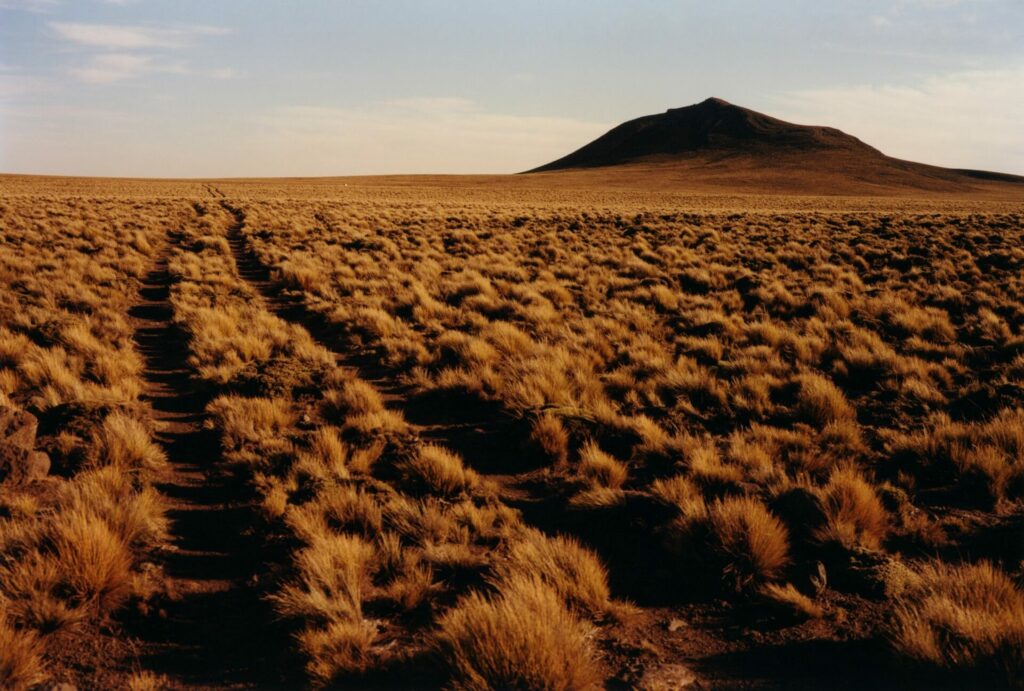A new photography book journeys into the fragile landscapes and everyday lives of WLT partners in Argentina’s Patagonia.
‘100% (Ciento por Ciento)’ is a new book of photographs by Colin Dodgson made in partnership with the World Land Trust. It captures the trip that Colin made in the company of WLT Ambassador Jonny Lu to two WLT-funded wildlife reserves in Southern Argentina.
“All species deserve to exist, no matter how insignificant they may seem”, Jonny Lu, WLT Ambassador.
Small is beautiful
This is the second book that Jonny and Colin have collaborated on with WLT, having produced Deeper Green in 2019 which focused on Belize’s rainforests. Scientists have their own – often high-tech – ways of documenting nature. But Colin’s use of an analogue camera means each photo captures the artist’s subjects in distinctive ways. 100% is a portrayal of the subtle details of nature conservation; those not often seen. From messy office desks and dirty car windows, to rangers playing saxophone.
Jonny explains the importance of the process of documenting these details: “You start with communicating the beauty of something, but then it quickly becomes about everything which surrounds that thing… humans, the scientists and communities that inhabit these places. They become equally important subjects in describing the animals and places they are fighting to protect”, says Jonny.
The vast expanse of the Somancura Plateau, dotted with its resident Guanacos. Credit: Colin Dodgson
Rocks that speak
Somancurá is an indigenous Mapuche word, meaning “the rock that speaks”. 100% illustrates the character of La Meseta Somuncurá, the vast volcanic rock plateau where WLT partner Fundación Hábitat y Desarrollo work. A windswept landscape with “horizon in every direction”, it communicates stories of evolutionarily distinct species. The El Rincon Stream Frog (Pleurodema somuncurense), is a muse for the book and is what you see on opening the first page. It may not appear as an overtly charismatic creature, Jonny remarks, but its survival hangs in a delicate balance. The frog lives alongside the small thumb-sized Naked Characin fish, also featured in the book. It has evolved to survive only in the Valcheta which is constantly heated by hot springs.
The Naked Characin fish is so named due to adult stage of its life where it reasorbs its small scales. It lives out adulthood naked with a greasy and sponge-like texture. Credit: Colin Dodgson.
The breath of whales
The other key location for many of the book’s images is the Estancia La Esperanza nature reserve. Situated along the coast, the intense blue sea and rhythmic waves are a contrast to the dusty, orange tones of the Somuncurá Reserve. 100% contains images of the charismatic research station where Fundación Patagonia Natural monitor the migration of Southern Right Whales. Visible from within just 50 metres of the shore, Jonny recalls “it was possible to hear the unmistakable sounds of them breathing”.
On the shores of the Golfo Nuevo (Province of Chubut, Patagonia Argentina) Fundación Patagonia Natural operate the Punta Flecha Observatory. Here, they document the migration of the Southern Right Whale (Eubalaena australis). Credit: Colin Dodgson.
Inspiring action
Photography can be a tool for inspiring a positive chain reaction. With this book, Colin and Jonny hope that: “these photographs provide a visceral insight into the work that WLT partners do and emphasise the beauty in the seemingly ordinary.”
100% was designed by Jonny Lu Studio, and all profits made from the book will be donated to WLT.
It is available to purchase at cientoporciento.co.uk.
Two Magellanic penguins. Credit: Colin Dogdson

